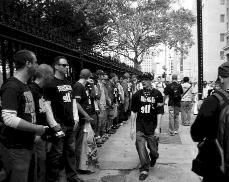Seven years after 9/11, many family
members still grieve while concerned citizens
still question what happened.
The anniversary of Sept. 11, 2001, was
marked by the annual solemn ceremony
of grief held by thousands of surviving
family members, reflective citizens and
others in the pit of the former World
Trade Center.
Family members began signing in at
dawn for the ceremony.
Security was tight throughout the entire
region of lower Manhattan, with barricades
lining the sidewalks to control the
flow of pedestrian traffic. Even to the
casual eye, it seemed like at least one
police officer was always within line of
sight.
At 8:46 a.m., a bell rang at the WTC site
to mark the time of the first impact. It was
loud enough to be heard by everyone
within a block of Ground Zero.
Without instruction, all of the nearby
pedestrians of NYC abruptly
froze from their normal rush. The
silence between rings was deafening.
The bell had temporarily
replaced the constant din of the
city. The bell slowly rang several
times, lasting about 20 seconds.
A few seconds after the last toll,
the everyday bustle returned as
quickly as it had vanished. The
same thing happened again at 9:03,
9:59 and 10:29 a.m., the times of the
second impact and the fall of each
tower, respectively.
A block away from Ground Zero,
a crowd of about 300 people who
question what really happened on 9/11
lined up along the sidewalk of Church
Street to demonstrate their views and
protest.
The throng called themselves “9/11
truthers,” but they are more commonly
known as conspiracy theorists. More than
a few of them held signs, and most wore
black T-shirts with phrases like
“Investigate 9/11” or “9/11 was an inside
job.” Some of the protesters wore yellow
t-shirts to identify themselves as volunteer
security and assisted in crowd control.
Many handed out flyers or DVDs to
anyone who would take them.
According to the conspiracy theorists,
the commonly accepted causes of 9/11 are
a lie, and the attacks were actually carried
out by secretive elements within the U.S.
government. The government’s motive,
they say, is to frighten the people into giving
up their freedoms in exchange for the
government’s protection, and the first
example they always use is the Patriot Act.
When asked why they believe 9/11 was
a fraud, many protesters mentioned WTC
Building 7, a 47-story skyscraper in the
WTC complex.
They say building 7 collapsed in what
looked like a controlled demolition at 5:20
p.m. on 9/11, but it was never hit by an
airplane.
Despite the National Institute of
Standards and Technology (NIST) releasing
a report last month that explained the
mysterious collapse of WTC 7, the protesters
remained convinced that it was taken
down by a controlled demolition. Other
evidence to support their claims mostly
consisted of admittedly eerie, albeit circumstantial,
evidence.
One example they used was that the
BBC had a report about the collapse of
WTC Building 7 20-minutes before it actually
fell.
Steve Rodgers, who said his friend’s dad
died in the attacks, told a reporter that
“you could fill up 10 of those notepads
with information contradicting the official
story, and there’d still be more to tell
you.”
Among the protesters was Patrick
Welsh, husband of Debra Welsh, who was
a flight attendant on Flight 93. He was
convinced by the conspiracy theorists’
evidence and resented being disrespected
for his views. “Just scratch the surface of
the facts on 9/11,” Welsh said, “and you’ll
quickly see that [the official story] is
moronic.”
Conversations among the conspiracy
theorists were usually about their views
on politics and their distrust of government
and big corporations. The people
there often said things such as, “They
should just put some golden arches on the
White House lawn,” or, “FEMA’s
response to Katrina was just a trial run for
martial law.”
Passersby who were not among the conspiracy
theorists considered their views
offensive or just crazy.
Shmuel Totchinsky, a third-generation
New Yorker, said, “They have no facts!”
That afternoon, the protesters moved to
a small park in front of the new WTC
building 7, where they held a candlelight
vigil dedicated to the 64 people who have
died after 9/11 due to respiratory problems
caused by the toxic dust created by
the buildings’ collapse.
After the vigil, a few people passing
through the area stopped to debate with
the protesters about the evidence supporting
the conspiracy. The debates grew
emotional and loud, and went on for more
than two hours.
One person who joined in the debate
was an engineer named Chris Duncan
from New York. Duncan, who had debated
with the conspiracy theorists before,
remarked, “It’s a yearly sport.” About the
validity of their evidence, he said, “Their
arguments are based on exploiting halftruth.”
Another person who debated with
the protesters was Robert Clark, a 9/11
first responder. Clark said the conspiracy
theorists made strong claims without facts
to support them. “They show up to a gun
fight with a knife,” he said. He added, “I
started out annoyed and frustrated, but
now I’m confident that maybe these guys
are a little bit humbled and are no longer
NYC remembers 9/11 attacks at Ground Zero
CHRISTIAN PANNAPACKER
•
September 22, 2008


